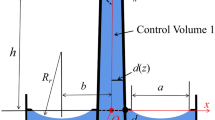Abstract
The results of the numerical calculations of oscillations of the liquid column free surface under the action on it of axial vibration in zero gravity are presented. On the basis of these calculations, an analytical model of the surface standing wave named the inertial‐capillary wave has been developed. Comparison of the analytical calculations with the data of the numerical calculations and the experiment performed in microgravity under the TEXUS program has been made. The numerical study of the thermocapillary convection stability in the presence of inertial‐capillary waves has shown that the change to the oscillation regime is very sharp upon reaching certain values of the vibration frequency and amplitude. The heat‐and‐mass transfer in growing semiconductor crystals by the floating‐zone method in zero gravity under the action of vibration with allowance for the surface waves has been investigated. The possibility of measuring vibrational accelerations onboard space vehicles by means of oscillations of the liquid‐column free surface are discussed.
Similar content being viewed by others
REFERENCES
R. J. Hung, C. C. Lee, and F. W. Leslie, Gravity jitter response slosh wave excitation on the fluid in a rotating dewar, Adv. Space Res., 11,No. 7, 201–208 (1991).
R. J. Hung, C. C. Lee, and F. W. Leslie, Gravity jitter affected slosh waves and the stability of a rotating bubble under microgravity, Adv. Space Res., 11,No. 7, 209–216 (1991).
R. J. Hung and K. L. Shyu, Cryogenic hydrogen reorientation and geyser initiation at various liquid-filled levels in microgravity, Adv. Space Res., 11,No. 7, 217–226 (1991).
J. Meseguer and J. M. Perales, Non-steady phenomena in the vibration of viscous cylindrical long bridges, Microgravity Sci. Technol., 5, 69–72 (1992).
H. F. Bauer, Axial response and transient behavior of a cylindrical liquid column in zero-gravity, Z. Flugwiss. Weltraumforsch, 14, 174–182 (1990).
R. S. M. Schulkes, Liquid bridge oscillations: analytical and numerical results, Microgravity Sci. Technol., No. IV/2, 71–72 (1991).
I. Martinez, J. M. Perales, and J. Meseguer, Stability of long liquid columns, in: P. R. Sahm, M. H. Keller, and B. Schiewe (eds.), Scientific Results on the German Spacelab Mission D2, DLR, Köln, Germany (1995).
I. Martinez, J. M. Perales, and J. Meseguer, Response of a liquid bridge to an acceleration varying sinusoidally with time, in: L. Ratke, H. Walter, and B. Feuerbacher (eds.), Materials and Fluids under Low Gravity, Berlin, Springer (1996), pp. 271–279.
Y. Kamotani and S. Ostrach, Effects of g-jitter liquid free surfaces in microgravity, Microgravity Sci. Technol., No. IV/2, 144–145 (1991).
A. I. Feonychev, I. S. Kalachinskaya, and V. I. Pokhilko, Deformation of fluid column by action of axial vibration and some aspects of high-rate thermocapillary convection, in: Proc. Third Microgravity Fluid Physics Conf., Cleveland, Ohio, USA, June 13–15, 1996, NASA Conf. Publ. No. 3338 (1996), pp. 493–498.
A. I. Feonychev and I. S. Kalachinskaya, Effect of variable accelerations on crystal growth by the floating-zone method onboard spacecraft, Kosmich. Issled., 39,No. 4, 400–409 (2001).
C. W. Hirt and B. D. Nicols, Volume of fluid (VOF) method for the dynamics of free boundaries, J. Comp. Phys., 39, 201–205 (1981).
B. D. Nicols, C. W. Hirt, and R. D. Hotchkiss, “SOLA-VOF”: A Solution Algorithm or Transient Fluid Flow with Multiple Free Boundaries, Report LA-8355, Los Alamos Scientific Laboratory (1975).
L. D. Landau and E. M. Lifshits, Theoretical Physics. Vol. 6. Hydrodynamics [in Russian], Nauka, Moscow (1986).
H. Batemen and A. Erdélyi, in: Higher Transcendental Functions. Hypergeometric Functions. Legendre Functions [Russian translation], Nauka, Moscow (1965), pp. 200–203.
H. Schlichting, in: Boundary Layer Theory [Russian translation], Nauka, Moscow (1969), pp. 90–91.
G. Chen and B. Roux, Analytical solution and numerical simulation of thermocapillary convection in floating zones, Adv. Space Res., 11,No. 7, 151–162 (1991).
V. M. Shevtsova, H. C. Kuhlmann, and H. J. Rath, Thermocapillary convection in liquid bridges with a deformed free surface, in: L. Ratke, H. Walter, and B. Feuerbacher (eds.), Materials and Fluids under Low Gravity, Proceedings, Berlin, Springer (1995), pp. 323–329.
F. K. Kalashnikov, V. L. Levtov, and V. V. Romanov, System of vibroprotection of air-borne technological equipment, Izv. Akad. Nauk SSSR, Mekh. Zhidk. Gaza, No. 5, 15–21 (1994).
Author information
Authors and Affiliations
Rights and permissions
About this article
Cite this article
Feonychev, A.I. Inertial‐Capillary Surface Waves and their Influence on Crystal Growth in Zero Gravity. Journal of Engineering Physics and Thermophysics 77, 348–359 (2004). https://doi.org/10.1023/B:JOEP.0000028514.02373.1f
Issue Date:
DOI: https://doi.org/10.1023/B:JOEP.0000028514.02373.1f



